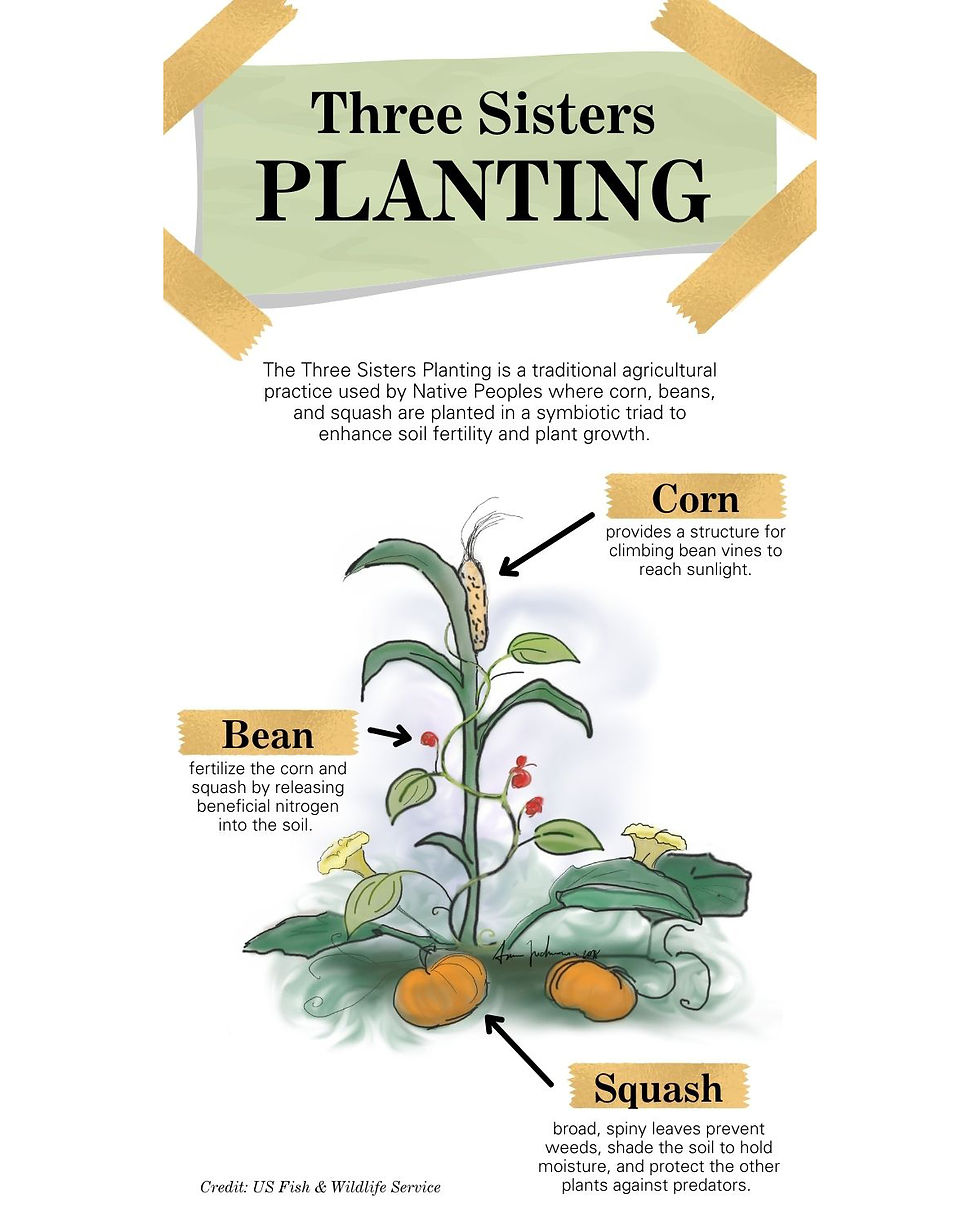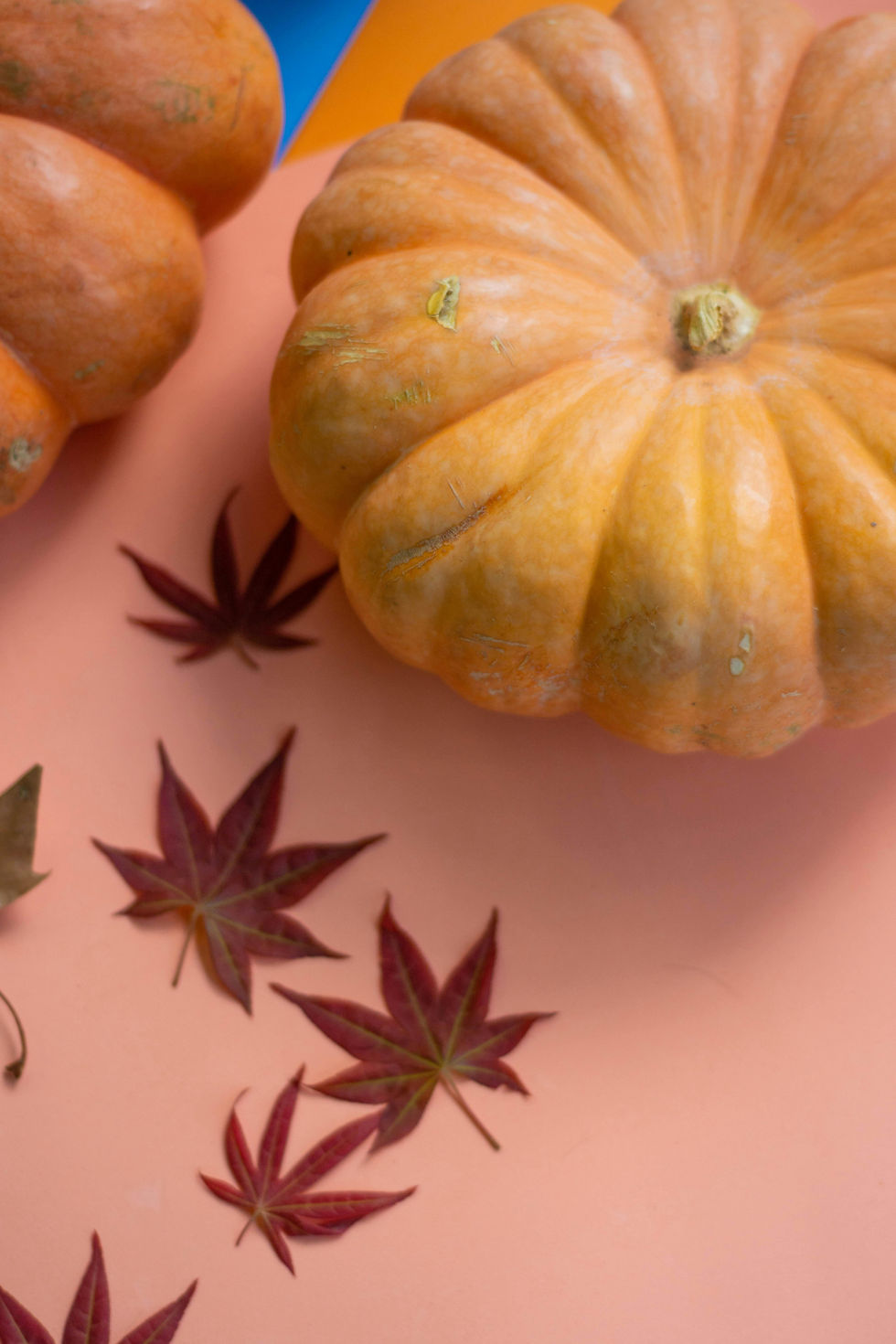Squash: A Cultural Jewel of Turtle Island
- Jon Mychal Heatherly
- Mar 7
- 5 min read
How Did Squash Shape Indigenous Agricultural Practices and Nourish Nations?

“Corn is the mother, beans are the father, and squash is the child.”— Haudenosaunee (Iroquois) Proverb
History
Squash (Cucurbita spp.) is one of the oldest cultivated crops in the world, domesticated in Mesoamerica over 10,000 years ago. Alongside corn and beans, squash formed the legendary Three Sisters—a companion planting system that sustained Indigenous civilizations for millennia.
Unlike modern squash, early varieties were bitter and grown mainly for their seeds. Over generations, Indigenous farmers selectively bred squash into diverse shapes, sizes, and flavors, creating varieties like butternut, acorn, kabocha, and zucchini.
By 6000 BCE, squash had spread throughout the Americas, traded by civilizations like the Olmec, Maya, and Aztecs. By 2500 BCE, Indigenous peoples in North America had incorporated squash into their agricultural systems, growing it as a staple food long before European contact.
Today, squash remains a global food source with varieties adapted to every climate, from the deserts of Mexico to the cold hills of New England.
Details

✍️ Scientific name: Cucurbita spp.
📍 USDA Zones: 3–10
🧑🌾 Difficulty: Easy
🍽 Flavor: Sweet, nutty, mild, earthy
🥔 Uses: Folk medicine, food, medicine, seed oil
💪 Nutrition: Fiber, Vitamins A & C, potassium, magnesium
🌎 Origin: Mesoamerica
🌱 Related: Cucumber, gourd, melon, pumpkin
🌿 Companions: Corn, beans, marigolds, radishes
🚫 Avoid near: Potatoes
🐛 Pests: Squash bugs, vine borers, cucumber beetles
🐝 Pollinators: Bees, butterflies
🥔 Varieties:
Squash comes in a wide range of varieties, categorized into summer squash (tender, harvested young) and winter squash (hard-skinned, stores well). Here are some notable types:
Summer Squash (Tender, Fast-Growing, Eat Fresh)
Zucchini – Classic green summer squash, prolific and mild-flavored.
Golden Zucchini – A bright yellow version of zucchini with a slightly sweeter taste.
Costata Romanesco – An Italian heirloom with ridges, nutty flavor, and firm texture.
Pattypan (Scallop Squash) – Round, scalloped squash that comes in yellow, white, and green.
Zephyr – A two-toned squash (yellow with a green tip), known for its tender texture.
Cousa – A Middle Eastern variety, shorter and thicker than zucchini, often stuffed.
Crookneck – A bright yellow squash with a curved neck and buttery flavor.
Straightneck – Similar to crookneck but with a straight shape, great for grilling.
Tatume – A round, Mexican squash that can be eaten young like zucchini or matured into a winter squash.
Winter Squash (Hard-Skinned, Long Storage, Richer Flavor)
Butternut – A sweet, nutty squash with smooth tan skin, great for soups and roasting.
Honeynut – A mini butternut variety with extra sweetness and deep orange flesh.
Acorn – Small, ridged squash with green or orange skin, mild and slightly nutty.
Delicata – Cream-colored with green stripes, very sweet, and the skin is edible.
Spaghetti Squash – Yellow squash that, when cooked, forms spaghetti-like strands.
Kabocha – A Japanese squash with deep green skin and rich, starchy, sweet flesh.
Buttercup – Similar to kabocha but with a rounder shape and sweeter taste.
Blue Hubbard – A massive, bluish-gray squash with dense, sweet flesh.
Red Kuri – A small, reddish-orange squash with a chestnut-like flavor.
Sweet Dumpling – Small, striped squash with extra sweet flesh, great for baking whole.
Turban Squash – A uniquely shaped squash with a nutty, dry texture, often used decoratively.
The Three Sisters: Ancient Foodways

Indigenous Mesoamericans perfected a companion planting method known as the Three Sisters, in which corn, beans, and squash were grown together for mutual benefit:
🌽 Corn provides a natural trellis for beans to climb.
🌱 Beans fix nitrogen in the soil, enriching fertility.
🎃 Squash spreads across the ground, suppressing weeds and conserving moisture.
Folklore

🌾 The Three Sisters Legend (Haudenosaunee/Iroquois)
The Haudenosaunee (Iroquois) creation story tells of three spirit sisters who depended on each other for survival. The eldest, Corn, stood tall. Bean, the middle sister, wrapped herself around Corn for support. Squash, the youngest, spread along the ground, protecting her sisters. Their unity ensured abundance, teaching humans the value of cooperation.
🌞 The Maya and the Squash of Rebirth
In Mayan mythology, squash symbolized rebirth and transformation. In some versions of the Popol Vuh, the Hero Twins—Hunahpu and Xbalanque—were reborn after their heads were transformed into squash, reflecting the plant’s association with life cycles.
🐍 Squash as a Protective Plant (Cherokee)
A Cherokee legend tells of a village terrorized by a giant serpent. An elder advised the people to plant squash vines around their homes. The thick, sprawling vines trapped the snake, saving the village. To this day, some Cherokee plant squash near their homes as a symbol of protection.
🦅 The Hopi Squash Blossom Tradition
The Hopi people consider squash blossoms sacred. Women traditionally wear a squash blossom hairstyle, symbolizing fertility and renewal. Today, the squash blossom motif remains a common element in Native American jewelry and art.
Growth & Harvest
Growth: Squash thrives in warm weather and is typically grown in well-draining soil with plenty of sunlight. It is a versatile plant, growing as both summer and winter varieties. Summer squashes, such as zucchini, have tender, edible skins, while winter squashes, like butternut and acorn, develop thicker skins and are harvested later in the season.
Squash vines can spread widely, with both bush and sprawling varieties available, and they require ample space for optimal growth. Regular watering and consistent care can promote strong, healthy vines and maximize yields.
Harvest: The timing of squash harvest depends on the variety. Summer squash is best picked when young and tender, usually around 4 to 6 inches long. These squashes should be harvested frequently to encourage more fruit production. Winter squash, on the other hand, is left to mature on the vine until its skin becomes hard and its color deepens.
When harvesting, it's important to use a sharp knife or pruners to cut the fruit, leaving a short stem attached to prevent rot. Once harvested, winter squash can be stored for extended periods in a cool, dry place, allowing it to be enjoyed throughout the colder months.
Culinary Tradition
Of the millions of tons of squash harvested each year, humans consume most of it, unlike corn, which is largely used for animal feed. Squash’s versatile nature allows it to be roasted, mashed, stuffed, or pureed, while squash seeds provide a nutritious snack rich in protein and healthy fats.
Traditional Indigenous Food Preparation
Roasted squash was a staple in Native American diets.
Squash seeds were dried and ground into flour.
Dried squash strips were stored for winter survival.
Recipe: Roasted Maple Squash

Ingredients
1 small squash (butternut, acorn, or kabocha)
2 tbsp olive oil
1 tbsp maple syrup
½ tsp cinnamon
Salt & pepper to taste
Instructions
Preheat oven to 400°F (200°C).
Cut squash in half, scoop out seeds, and slice into wedges.
Toss with olive oil, maple syrup, cinnamon, salt, and pepper.
Roast for 25–30 minutes, flipping halfway.
Serve warm and enjoy!
Final Thoughts
Squash is more than just a vegetable—it’s a living link to ancient agriculture, a sacred symbol in folklore, and a remarkable example of plant intelligence. From sustaining civilizations to protecting villages and nourishing modern tables, squash remains one of the most enduring crops in human history.
How do you enjoy squash? Let me know in the comments!




Comments